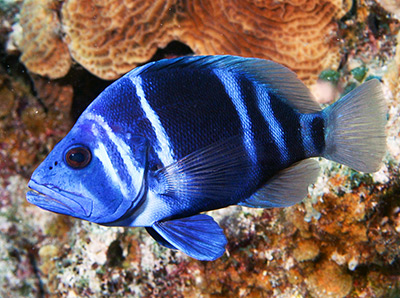The family Serranidae, the sea basses (not to be confused with a certain film character portrayed by Cam Neely), is a diverse assemblage of fishes ranging in size from tank-busting “bruisers” to diminutive species that are well suited to life in home aquaria. Included among the aquarium-friendly types are the so-called hamlets of the genus Hypoplectrus, which hail from the tropical western Atlantic, Caribbean, and Gulf of Mexico.
Several Hypoplectrus species are well worth the devotion of a little tank space, but today I’d like to focus on one in particular—the indigo hamlet (H. indigo).
Physical traits
H. indigo exhibits the deep body, large mouth, and forward-set eyes common to serranids. Its coloration is deep blue overall with light-blue to white vertical bands irregularly spaced along its flanks. The maximum recorded size for this species is a very manageable 5.5 inches.
Feeding
The indigo hamlet’s dietary focus shifts over its lifetime, with juveniles consuming benthic crustaceans and adults feeding primarily on small fish.
In Volume 1 of his Reef Fishes series, Scott Michael describes an interesting aspect of this hamlet’s feeding behavior: “Studies have shown that larger specimens feed extensively on the Blue Chromis (Chromis cyanea),” he writes. “They do so by stalking C. cyanea when these damselfishes feed above the reef. The hamlet will swim up to 1 m (3.3 ft.) over the bottom, slowly approaching schools of Blue Chromis until it is within striking range. The Indigo Hamlet’s blue bars help conceal it as it moves through the water column.”
Captive specimens will accept a wide variety of meaty food items, such as mysids; chopped fish, crustacean, and mollusk flesh; and frozen formulations for smaller carnivores.
Housing
I’ve seen minimum housing recommendations as low as 30 gallons for this species. While that will suffice for younger specimens, adults, while modest-sized for serranids, are fairly robust-bodied and contribute their fair share to a system’s bioload. So my recommendation is to upsize that minimum housing to something more along the lines of 50 gallons—significantly larger if you plan to keep conspecifics or congeners together.
Compatibility
H. indigo will usually coexist peacefully with other fish species that are too large to swallow and that aren’t inclined to bully hamlets. As alluded above, it is possible to keep different Hypoplectrus species and conspecifics together, though Michael recommends trying this only in larger systems (75 gallons or more) with all the specimens added simultaneously. Individual results may vary, so peaceful cohabitation among conspecifics or congeners isn’t guaranteed. Small ornamental crustaceans are best avoided as tankmates lest they become meals.
With respect to reef-friendliness, H. indigo is benign toward sessile invertebrates. The only drawback to this species in reef systems is its potentially high contribution to the bioload. But again, this is less of an issue in larger systems.




